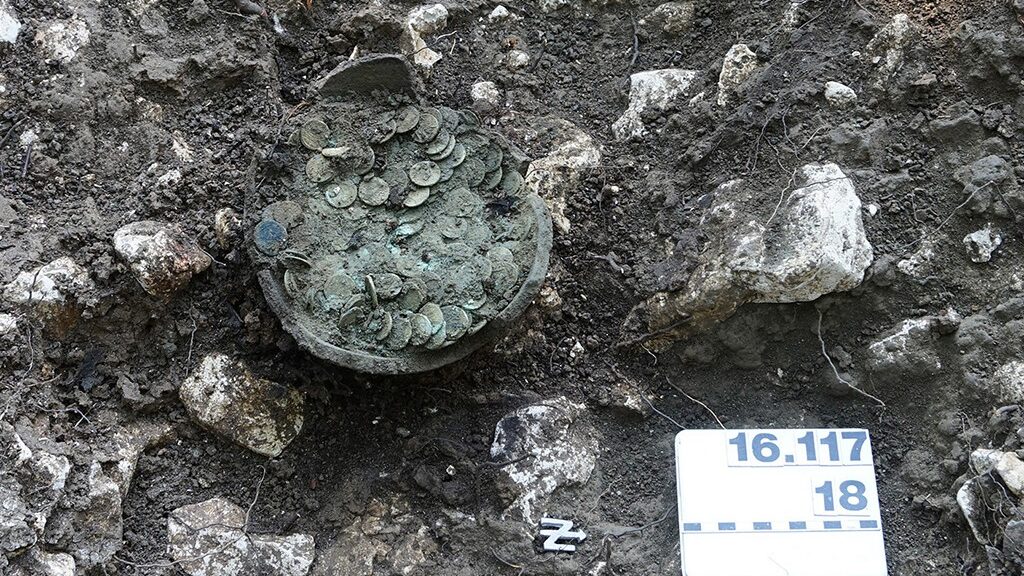Roman Coin Cache Discovered in Switzerland
An amateur treasure hunter in Switzerland has discovered a buried clay pot filled to the brim with 1,290 Roman coins that date to the fourth century A.D. However, an odd divider found within the pot — a piece of cowhide — has stumped archaeologists.

“It was clearly used as a separation,” said Reto Marti, head of the archaeological department of the canton of Basel-Landschaft (informally called Baselland) in northern Switzerland, and who helped to excavate and examine the coin pot. “But why the coins are separated in two parts we cannot tell for the moment.”
Daniel Lüdin, an amateur archaeologist with a metal detector, discovered the coin pot on Sept. 6, 2021, not too far from the 13th-century Wildenstein Castle in Bubendorf, a municipality in Baselland, according to a translated statement released on April 13.
When the metal detector began beeping, Lüdin started to dig and soon discovered several Roman coins and pottery fragments.
Realizing he had unearthed a Roman coin hoard, Lüdin carefully reburied the find and told Archäologie Baselland of his discovery. This decision saved valuable clues about the stash, as the archaeologists were later able to excavate the pot in a large earthen block and then CT scan its contents without disturbing them.
During a CT scan, an object is bombarded with powerful X-rays that software can transform into a virtual 3D image of the specimen. It was during this scan that the scientists discovered the cowhide dividing the coins into two separate piles.
The 9-inch-tall (23 centimetres) pot is filled with “a large amount of small change” — coins made of a copper alloy and a small percentage of silver, according to the statement. In total, all of the coins are worth about as much as a solidus, a pure-gold coin introduced by Emperor Constantine during the late Roman Empire that weighed about 0.15 ounces (4.5 grams). A solidus was worth about two months’ salary for a soldier at the time.


“There are two types of coins in the pot, but the exact denomination of these late antique bronze coins is not known,” Marti told Live Science in an email. All of the coins were minted, with inscriptions and designs on each side, during the reign of Emperor Constantine (A.D. 306 to 337).
It’s not too surprising to find Roman coins in this region, which was part of a Roman Empire province, Marti said. “There are even some coin hoards with much more coins than the Bubendorf finds,” he noted. But something big sets these other coin hoards apart from the new finding: The past findings were buried in times of crisis.
There were several wars during the late third and the middle of the fourth century A.D., which prompted many people to bury their Roman money for safekeeping. In contrast, the Bubendorf hoard dates to a time of relative peace and some economic recovery, about A.D. 330 to 340.
“Because of this, the new find will be very important,” Marti said. “It will give a very detailed insight into the use of money and the circulation of coins in the time of the Roman emperor Constantine the Great.”
So, this coin pot has two mysteries: Why was it buried during a time of political stability, and why does it have a cowhide divider in it?
“Maybe it was an offering to the gods,” Marti said. Another idea is that this area once bordered three Roman estates, so perhaps this burial location had something to do with that boundary, he added.
It’s rare to find such a large hoard from the last years of Constantine the Great’s life, said Marjanko Pilekić, a numismatist and research assistant at the Coin Cabinet of the Schloss Friedenstein Gotha Foundation in Germany, who was not involved with the new find.
“A stroke of luck is certainly also the survival of the storage vessel, which contained not only coins but also a piece of leather, organic material that rarely survives,” Pilekić told Live Science in an email. Perhaps, the detailed excavation will reveal “which coins belonged to which side [of each Roman estate], which may help in the interpretation.”
